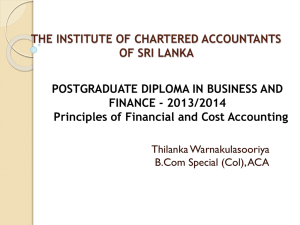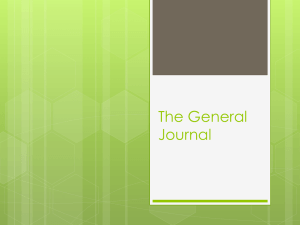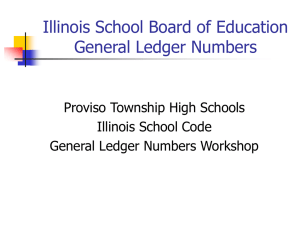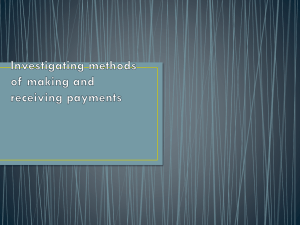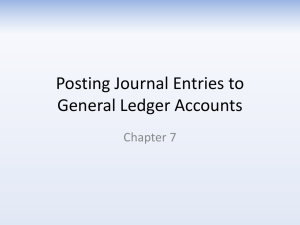CASH BOOK - WordPress.com
advertisement
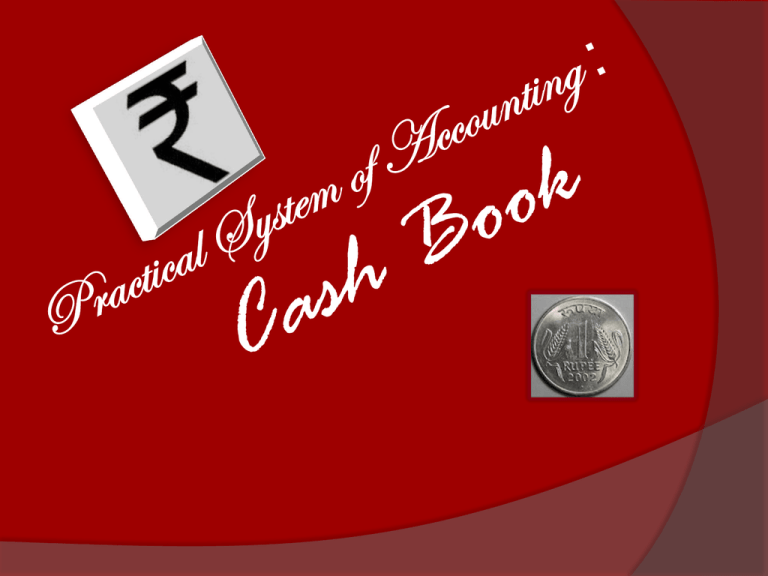
INTRODUCTION All the transactions are first entered in the journal in the order in which they occur and from the JOURNAL they are posted to the respective accounts in the ledger. But this involves a tremendous amount of work because each transaction requires a separate DEBIT to the receiving account and CREDIT to the giving account to bring into record the two-fold aspect of each transaction. Thus when all transactions used to be recorded in the journal, the book became too unwieldy to handle and the desired information to be extracted from the books of accounts was difficult to obtain readily. Therefore all cash transactions began to be recorded separately in a book called “CASH BOOK” ,which later began to be used to record bank and discount transactions as well besides cash transactions. By doing so daily checking of cash in hand and periodical checking of cash in hand and periodical checking of bank balance was rendered quick and easy. The practice these days is to keep a separate subsidiary book to record such transactions of identical nature rather than recording many times during a month. Each subsidiary book is meant for recording all the transactions of a similar nature. For Example: All cash transactions may be recorded in one book, all credit purchase transactions in another book and all credit sale transactions in yet another book and so on…. Cash Book Purchase Book i. Sales Book Purchase Sales Return Return Book Book Single Column Cash Book ii. Double Column Cash Book iii. Triple Column Cash Book iv. Petty Cash Book Bills Bills Journal Receivables Payables Proper Book Book 1. CASH BOOK: This book is used for recording all transactions relating to cash receipts and cash payments. All banking transactions relating to receipts and payments are also recorded in this book. 2. PURCHASE BOOK: This book is used for recording the credit purchases of goods. 3. SALES BOOK: This book is used for recording the credit sales of goods. 4. BILLS RECEIVABLE BOOK: This book is used for recording the receipts of bills receivables, promissory notes or hundis from various parties. The trader is to receive payment for these bills. 5. BILLS PAYABLE BOOK: This book is used for recording the issue of bills payables, promissory notes or hundis to various parties. The trader is to make payment for these bills. 6. PURCHASE RETURN BOOK or RETURN OUTWARD BOOK: When the goods previously purchased on credit are returned to the suppliers, such returns are recorded in this book. 7. SALES RETURN BOOK OR RETURN INWARD BOOK: When goods previously sold on credit are returned by the customers, such returns are recorded in this book. 8. JOURNAL PROPER: This book is used for recording the transactions which cannot be recorded in any of the above mentioned books. Thus, instead of recording the transactions in a single journal, eight journals are prepared as mentioned above. ♦ A cash book records all cash transactions. ♦ As the number of cash transactions in a business is quite large, so it is quite impracticable and inconvenient to record all cash transactions in the journal. ♦ This book enables a businessman to know the balance of cash in hand and at bank at any point of time. ♦ It also gives information about the daily receipts, payments and the closing cash balance at the end of each day. Cash book achieves a dual purpose: As all cash transactions are recorded for the first time in the cash book, it is therefore a SUBSIDIARY BOOK (book of original entry). But when a cash book is prepared, cash account in the ledger is not prepared. In this way, cash book represents the cash account and hence, becomes the PRINCIPAL BOOK of accounts. Distinction between Cash A/C And Cash Book S. No. Cash Account Cash Book 1. It is an account in the Ledger. It is a separate book maintained for recording Cash transactions. 2. It is opened in the ledger and posting is done in this account from journal. It is a book of original entry because all cash transactions are first of all recorded in Cash book and then posted from Cash book to various accounts in the ledger. 3. When transactions of Cash are recorded in journal, it is necessary to open a Cash Account in ledger. When transactions of Cash are recorded in Cash book, there is no necessity to open a Cash account in the ledger. 4. It only records one aspect of a transaction, i.e., Cash. It records both the aspects of transaction. Cash Book plays dual role as a book of original entry as well as a ledger. It is a subsidiary book because all cash transactions are first recorded in it and then from cash book posted to various account in the ledger. The recording of transactions in the cash book takes place the shape of a ledger account. As receipts of cash are entered on debit side and payments of cash on the credit side, so there is no need of preparing cash account in the ledger. Therefore cash book serves the purpose of a ledger account. 1. Just like a journal, transactions in the cash book are recorded for the first time from source documents. 2. Just like a journal transactions in the cash book are also recorded date wise, i.e. in a chronological order, as and when they take place. 3. Just like a journal, transactions from cash book are also posted to the relevant accounts(except cash account) in the ledger. 4. Just like a journal, a cash book also contains a Ledger Folio Column. 1. Form of cash book closely resembles to a ledger account. It has two equally divided sides having identical columns. The left side(receipt side) is the debit side and the right side(payment side) is the credit side. 2. Cash book itself serves as a cash account also and as such when a cash book is maintained, cash account is not opened in the ledger. The cash book, hence, is a part of ledger also. 3. Just like a ledger account, the words “To” and “By” are used in a cash book also. 4. It is balanced just like a ledger account. 1. Cash book prevents duplication of work in recording cash transactions in the journal and then posting them into the ledger as a cash book acts both as a journal as well as a ledger 2. A cash account is not opened when a cash book is maintained, therefore it prevents the size of the ledger to be too voluminous. 3. Both cash and bank transactions can be entered in the cash book. 4. It helps a businessman to know the balance of Cash in hand and at bank at any point of time without waiting for posting from the journal. 5. It gives daily information about receipts, payments and the closing cash and bank balance at the end of each day. 6. The Cash balance, as shown in cash book, must be equal to the actual cash in hand. A regular verification of the balances reduces the possibility of any kind of misappropriation of cash. Simple Cash Book Petty Cash Book Types of Cash Book Three Column Cash Book Two Column Cash Book SIMPLE CASH BOOK This type of cash book makes a record of all the receipts and payments of cash. All cash received in the form of coin, notes, cheques, postal orders, bank drafts, or treasury notes will be recorded on the debit side and payments on the credit side. The ruling of this type of cash book is as follows: Dr. (Receipts) Date Particulars SIMPLE CASH BOOK R.No. L.F. Amount Rs. Date Cr.(Payments) Particulars V.No. L.F Amount Rs. 1. DATE: Day, month and the year of the transaction is recorded in this column. 2. PARTICULARS: The name of the account in respect of which cash has been received or payment has been made is recorded in this column. 3. R.No. (RECEIPT NUMBER): The serial number of the receipt certifying the amount received is written in this column. 4. V.No. (Voucher Number): The serial number of the voucher certifying the payment is written in this column. 5. L.F. (Ledger Folio): This column records the page number of the ledger where the posting of this account has been made. 6. AMOUNT: The amount of the transaction is recorded in this column. Opening balance on the debit side of cash book is not posted to any account in the ledger as it comes in the cash book from the opening entry recorded in the journal proper. The other transactions recorded on the debit side of cash book are posted to the credit side of the respective accounts in the ledger to complete the second aspect of the entry. Similarly, the entries appearing on the credit side of cash book are posted to the debit of respective accounts in the ledger. At regular periodic intervals, preferably daily, cash book should be balanced like other ledger accounts and the balance shown by it should be equal to cash in hand, if no mistake or fraud has been committed. Cash book should always show a debit balance (i.e., cash in hand) because total cash paid can never exceed the opening balance plus cash received. Illustration Enter the following transactions in a single column cash book: 2012 July 01 July 08 July 15 July 20 Balance of cash in hand Purchased goods for cash from X Sold goods for cash to Y Received commission Paid commission July 28 Paid to A on account of sales July 31 Paid salary to the office clerk and office rent Rs. 16000 4200 5800 1650 1550 8150 2000 1600 SOLUTION: DATE PARTICULARS R. L AMOUNT No F 2012 DATE PARTICULARS V L AMOUNT No F 2012 July 1 To Balance b/d 16000 July 08 By Purchases 4200 July 15 To sales 5800 July 20 By commission 1550 July 20 To commission 1650 July 28 By A 8150 July 31 By salary 2000 July 31 By office rent 1600 July 31 By balance c/d 5950 23450 Aug 1 To balance b/d 5950 23450 Double Column Cash Book When discount is allowed on the receipt of cash and discount is received when payment is made to the suppliers, it becomes desirable to add discount column along with cash on both sides of the cash book. There will be two columns for discount and cash on each side of the cash book and that is why it is known as Double or Two Column Cash Book. Discount column is only memorandum column and not based on the double entry system. Cash discount is allowed by a creditor to a debtor when the latter pays the amount of goods purchased by him either immediately or within a specific period. It is an incentive given to a debtor for making an early payment. Dr. Date Particulars CASH BOOK Rno LF Discount Cash Date Rs. Rs. Particulars Rno LF Discount Rs. Cr. Cash Rs. The cash column of Cash Book is balanced in the same way as in simple cash book. Discount column of such cash book on both sides will not be balanced but simply totals are done. The posting of cash columns will be same as it is done in simple cash book. Each item of discount allowed appearing on the debit side of the cash book will be posted to the credit of respective personal account and total of discount column should be posted to the debit side of Discount Account with the words “To Sundry Accounts” or “Amount As Per Cash Book”. Similarly, each item of discount received appearing on the credit side of the cash book in the discount column will be posted to the debit of respective personal account and total of discount received column should be posted to the credit of Discount Account with the words “By Sundry Accounts” or “By Amount as per Cash Book”. ILLUSTRATION Enter the following transactions in a cash book with cash and discount columns : 2012 Rs. June 01 Balance of cash in hand 7000 June 01 Received cash from Sohan 2000 June 03 Paid into bank 2800 June 09 Paid to Mehta and sons for goods purchased 3000 June 10 Received from cash sales 2800 June 11 Paid for cash purchases 2920 and received discount 1080 June 13 Withdrew for personal use 2000 June 19 Received from Kapoor Bros. 2160 and allowed discount 1040 June 20 Drew from bank for office use 1800 SOLUTION: DATE PARTICULARS 2012 L DISCF OUNT Rs. June1 To Balance b/d June1 To Sohan June10 To Sales June19 To Kapoor Bros. June20 To Bank CASH DATE Rs. 2012 7000 1040 L DISCF OUNT Rs. CASH Rs. June3 By Bank 2800 June9 By Mehta & Sons 3000 2000 1040 PARTICULARS 2800 June11 By Purchases 2160 June13 By Drawings 2000 1800 June30 By Balance c/d 5040 15760 1080 1080 2920 15760 BANKING TRANSACTIONS Money can be deposited with a bank by opening three types of accounts: Current Account • Money can be deposited and withdrawn as and when required without any notice. • Facility of overdraft is available. • No interest is allowed. • Preferred by businessmen. Savings Bank Account • Deposits can be made when desired. • Restrictions on the number and amount of withdrawals. • Interest is allowed. • Does not suit businessmen. Fixed Deposit Account • Money is deposited for a fixed period. • Withdrawal is often made when the period expires. • Fixed rate of Interest is received on the deposit. DEPOSITS AND WITHDRAWALS Cash or cheques and demand drafts can be deposited in an account (saving or current) opened in the bank by filling up a form called pay-in-slip. There is a counterfoil (perforated) in the pay-in-slip which is stamped and signed by the banker’s cashier and returned to the client as a proof of money deposited in the bank. Separate pay-in-slips have to filled in for depositing cash, local cheques, outstation cheques and demand drafts. Different pay-in-slips will be filled in for cheques drawn on different banks whereas one pay-in-slip for more than one cheque drawn on the same bank can serve the purpose. Withdraws from a bank account can be made by means of cheques or by filling in withdrawal forms supplied by the bank. According to S e c t i o n 6 of N e g o t i a b l e In s t r u m e n t A c t , 1 8 8 1 , “A cheque is a bill of exchange drawn on a specified banker and not expressed to be payable otherwise than on demand”. It is a negotiable instrument which does not express any time of payment and is payable on demand. TYPES OF CHEQUES i. Open cheque: An open cheque is one which can be encashed at the counter of the bank. It need not be deposited in an account through a bank. It can be of two types: (a) Bearer cheque: When a cheque is payable to a person named in the cheque or the bearer thereof, it is called a bearer cheque. (b) Order cheque: An order cheque is payable to the person named in the cheque or his order. ii. Crossed cheque: When a cheque is not payable at the counter of the bank and is collected through a bank, it is called a crossed cheque. According to section 85 of the Indian Negotiable Instrument Act a bank draft is “an order to pay money drawn by one office of a bank upon another office of the same bank for a sum of money payable to order on demand”. They are popularly known as demand drafts because they are always payable on demand without any days of grace and there cannot be any bearer drafts. It is always payable to a certain person named in the draft or to his order. They are issued by banks to customers on request and against payment by the customer (usually effected by debiting the customer’s account). S. No. Cheque Demand Draft 1. Drawn by customer of the bank. Drawn by one office of a bank upon another office of the same bank. 2. May be drawn payable to bearer. Cannot be made payable to bearer. 3. No commission is involved. For getting the facility of a bank draft, commission is payable to bank. 4. Payment can be stopped. Payment cannot be stopped easily. 5. It may be dishonoured. It will not be usually dishonoured. THREE COLUMN CASH BOOK These days payments are mostly made to other parties by cheques . Similarly, we get cheques from other parties for the amounts which are due to them. Under such circumstances, it is desirable to add one more column for Bank on both sides of the cash book which already contains cash and discount columns. Dr. Date Cash Book Particulars LF Discount Cash Bank Date Rs. Rs. Rs. Cr. Particulars LF Discount Rs. Cash Bank Rs. Rs. All the contents of a triple column cash book are the same as a double column cash book except the discount column. Discount columns are memorandum columns and are not based on double entry system. Cash columns represent cash account and must have a debit balance. Bank column may have debit or credit balance. If amount withdrawn is more than deposited in the bank, it will have credit balance or overdraft as per bank column of the cash book. ILLUSTRATION Enter the following transactions in a three column cash book: 2012 Jan 01 Cash in hand Cash at bank Jan 05 Cash Sales Jan 08 Paid into bank Jan 10 Received a cheque from X Jan12 Paid into bank X‘s cheque for Jan15 Received cheque from Y and allowed him discount Jan18 Paid to Anu by cheque and discount allowed by him Jan 25 Cash purchases Jan 29 Withdrew from bank for office use Rs. 6374 16490 7400 8000 1700 1700 1950 1050 1980 120 3500 6000 SOLUTION: DATE PARTICULARS V L DISCN F OUNT 2012 Rs. Jan1 To balance b/d Jan5 To sales Jan8 To cash Jan10 To X Jan12 To cash Jan15 To Y Jan29 To bank To balance b/d BANK DATE Rs. Rs. 2012 16490 Jan8 By bank C Jan12 By bank C Jan18 By Anu Jan25 By purchases Jan29 By cash Jan31 By bal c/d 6374 7400 C 8000 1700 C 1700 1050 C PARTICULARS V L DISCN F OUNT Rs. CASH BANK Rs. Rs. 8000 1700 120 1980 3500 C 6000 1950 6000 1050 Feb1 CASH 23424 26190 10224 18210 120 10224 18210 23424 26190 multi-columnar cash book • Multi-columnar cash book is usually maintained by large business enterprises. • The receipts and payments side of this book are divided into such columns which are frequently needed for making cash transactions which occur again and again. • Cash transactions pertaining to columns pertaining to columns provided in the cash book are written in their particular columns and the total of such columns like discount is posted in their accounts posted in the ledger. • In this way posting of cash transactions occurring again and again is not required, only posting of the total of various columns is made in their respective accounts. This type of cash book can be maintained to have control on cash in hand. It is like a three column cash book with a difference that of on any day cash balance falls short by the minimum amount to be maintained in hand, the shortage of minimum cash in hand will be made up by withdrawing cash from a bank by passing a contra entry. Similarly, if on any day cash in hand is found to be excess than the maximum amount of cash in hand to be maintained, the excess cash in hand will be deposited into the bank by passing a contra entry. However, if cash in hand lies between the minimum and maximum balance of cash to be maintained, no contra entry will be made for withdrawal or deposit of cash into bank. It is undesirable to burden a cash book with a large number of transactions with numerous small payments. Therefore a separate book called “PETTY CASH BOOK” is maintained to record such small transactions. The person who records such transactions is called a ‘PETTY CASHIER’ In such a petty cash book, a separate column for each usual head of expenditure and for the total small cash payments is provided. This book is also known as “Analytical Petty Cash Book” because the various small cash payments get automatically analyzed when they are entered in their respective columns. Dr. Cash Received Date Petty Cash Book Particulars Vr.No. Total Stationery & Printing Cartage Cr. Conveyance Postage & Telegram Sundry Expenses POINTS TO REMEMBER WHILE MAINTAINING PETTY CASH BOOK i. The amount fixed for petty cash should be sufficient so that small payments for a fixed period may be easily met out of that amount. ii. The amount to be reimbursed to the petty cashier must be supported by the vouchers (filed in order) along with a statement of total payments. iii. The petty cashier should be authorized to make payment with the consent of the head cashier upto a specified limit. iv. The petty cashier should not receive any cash except for the reimbursement of small payments. ILLUSTRATION Enter the following transactions in an Analytical Petty Cash Book: Each month starts with an opening cash balance of Rs. 2000 2012 March March March March March March March March March March March March 01 03 05 06 07 08 10 18 25 26 27 30 Wages paid to peon Coolie wages Stationery Railway Freight Postage Stamps Ink Telephones Unpaid Letters Soap Sweeper’s Wages Sundry Expenses Printing Price List Rs. 250 160 125 110 150 110 110 104 106 130 200 190 SOLUTION: Amt. Recd. Date Particulars V. No. Total Payment Postage & Telephone Stationery & Printing Conveyance Wages Sundry Expenses Rs. 2012 Rs. Rs. Rs. Rs. Rs. Rs. 2000 1/3 To balance b/d 1/3 By Peon Wages 1 250 250 3/3 By Coolie Wages 2 160 160 5/3 By Stationery 3 125 6/3 By Railway Freight 4 110 7/3 By Postage Stamps 5 150 8/3 By Ink 6 110 10/3 By Telephones 7 110 110 18/3 By Unpaid Letters 8 104 104 25/3 By Soap 9 106 26/3 By Sweeper’s Wages 10 130 27/3 By Sundry Expenses 11 200 30/3 By Printing of Price List 12 190 1745 31/3 2000 By balance c/d 255 2000 125 110 150 110 106 130 200 190 364 425 110 540 306 Cash book is a subsidiary book and a principal book of recording. It is a journalized ledger. There are four types of cash book, i.e., simple cash book, two column cash book, three column cash book, and multi column cash book. There are two types of cheques, i.e., open and bearer cheques.
